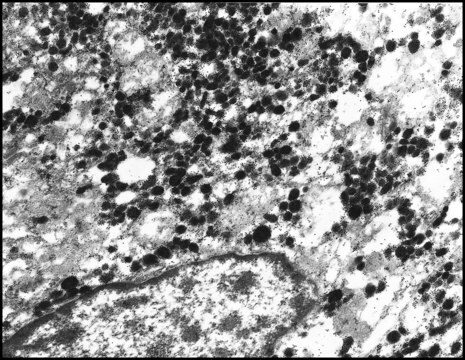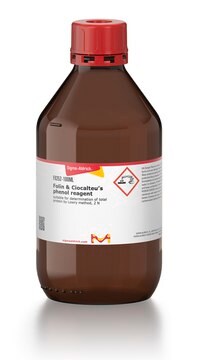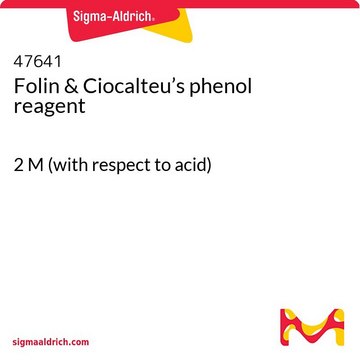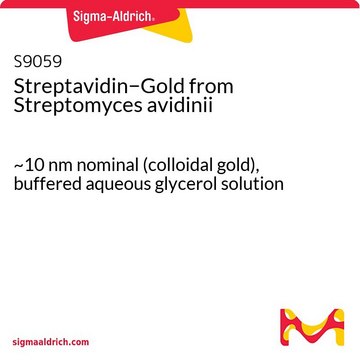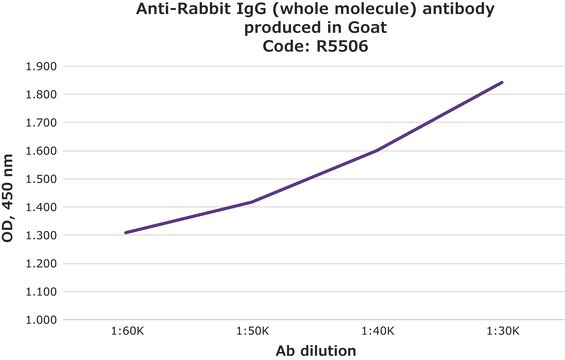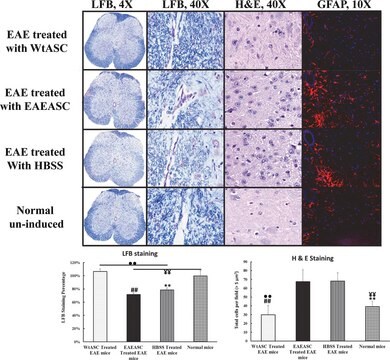G7277
Anti-Rabbit IgG (whole molecule)−Gold antibody produced in goat
affinity isolated antibody, aqueous glycerol suspension, 5 nm (colloidal gold)
Sinonimo/i:
Goat Anti-Rabbit IgG
Autenticatiper visualizzare i prezzi riservati alla tua organizzazione & contrattuali
About This Item
Prodotti consigliati
Origine biologica
goat
Livello qualitativo
Coniugato
gold conjugate
Forma dell’anticorpo
affinity isolated antibody
Tipo di anticorpo
secondary antibodies
Clone
polyclonal
Stato
aqueous glycerol suspension
tecniche
dot blot: suitable
western blot: suitable
Dimensione particelle
5 nm (colloidal gold)
Temperatura di conservazione
2-8°C
modifica post-traduzionali bersaglio
unmodified
Descrizione generale
Goat polyclonal anti-Rabbit IgG (whole molecule)−Gold antibody binds all rabbit IgGs. It has no observed reactivity with human serum proteins.
Immunoglobulins (Igs) have two heavy (H) and two light (L) chains, held together by disulphide linkages. They belong to the immunoglobulin super-family. The heavy chain has one variable N-terminal region and three to four constant (CH1-CH4) C-terminal regions. The light chain has one variable and constant region. IgGs are subclassified into IgG1, IgG2, IgG3 and IgG4. The IgG gene is localised on rabbit chromosome 20. Gene conversion events are observed in rabbit IgG gene.
Rabbit IgG is a plasma B cell derived antibody isotype defined by its heavy chain. IgG is the most abundant antibody isotype found in rabbit serum. IgG crosses the placental barrier, is a complement activator and binds to the Fc-receptors on phagocytic cells. The level of IgG may vary with the status of disease or infection.
Immunogold labeling is a technique whereing antibodies, especially secondary antibodies, are labeled with colloidal gold. These gold conjugated antibodies generate electron dense particles that are visable using electron microscopy.
Immunogold labeling is a technique whereing antibodies, especially secondary antibodies, are labeled with colloidal gold. These gold conjugated antibodies generate electron dense particles that are visable using electron microscopy.
Applicazioni
Anti-Rabbit IgG (whole molecule)−Gold antibody produced in goat has been used in electron microscopic analysis of exosomes in glioma cells, clathrin proteins and retinal tissues.
Goat polyclonal anti-Rabbit IgG (whole molecule)−Gold antibody may be used as a primary or secondary antibody that enables the labeling of rabbit IgG for detection by electron microscopy.
Azioni biochim/fisiol
Digestion of IgG by papain results in generation of fragment antigen binding (Fab). Pepsin digestion of IgG results in fragment crystallizable (Fc). Fc regions of IgG antibody have enormous therapeutic potential and are exploited for the development of therapeutic antibodies. IgG1 class is the most abundant and its deficiency results in hypogammaglobulinemia. IgG2 deficiency increases susceptibility to bacterial infections. IgG3 mediates effector functions and IgG4 is associated with asymptomatic infection.
Altre note
Antibody adsorbed with human serum proteins.
Stato fisico
Colloidal suspension in Tris buffered saline, pH 8.2, with 30% glycerol (v/v), 1% bovine serum albumin (w/v), and 15 mM sodium azide.
Esclusione di responsabilità
Unless otherwise stated in our catalog or other company documentation accompanying the product(s), our products are intended for research use only and are not to be used for any other purpose, which includes but is not limited to, unauthorized commercial uses, in vitro diagnostic uses, ex vivo or in vivo therapeutic uses or any type of consumption or application to humans or animals.
Non trovi il prodotto giusto?
Prova il nostro Motore di ricerca dei prodotti.
Codice della classe di stoccaggio
10 - Combustible liquids
Classe di pericolosità dell'acqua (WGK)
WGK 3
Punto d’infiammabilità (°F)
Not applicable
Punto d’infiammabilità (°C)
Not applicable
Dispositivi di protezione individuale
Eyeshields, Gloves, multi-purpose combination respirator cartridge (US)
Scegli una delle versioni più recenti:
Possiedi già questo prodotto?
I documenti relativi ai prodotti acquistati recentemente sono disponibili nell’Archivio dei documenti.
I clienti hanno visto anche
Zhiguang Chang et al.
Nature communications, 7, 11537-11537 (2016-05-07)
Neutrophil extracellular traps (NETs), composed primarily of DNA and proteases, are released from activated neutrophils and contribute to the innate immune response by capturing pathogens. Plasmodium falciparum, the causative agent of severe malaria, thrives in its host by counteracting immune
Exosomes from glioma-associated mesenchymal stem cells increase the tumorigenicity of glioma stem-like cells via transfer of miR-1587
Figueroa J, et al.
Cancer Research, canres-ca2524 (2017)
Simara Price et al.
Microbiology (Reading, England), 160(Pt 10), 2148-2156 (2014-07-11)
Collagen molecules are structural in nature and primarily found in eukaryotic, multicellular organisms. Recently, a collagen-like protein, TrpA, was identified and characterized in the marine cyanobacterium Trichodesmium erythraeum IMS 101, and it was shown to be involved in maintaining the
Localization of alphaA-Crystallin in Rat Retinal Muller Glial Cells and Photoreceptors
Zayas-Santiago A, et al.
Microscopy and Microanalysis, 24(5), 545-552 (2018)
Javier Figueroa et al.
Cancer research, 77(21), 5808-5819 (2017-09-01)
Tumor-stromal communications impact tumorigenesis in ways that are incompletely understood. Here, we show that glioma-associated human mesenchymal stem cells (GA-hMSC), a newly identified stromal component of glioblastoma, release exosomes that increase the proliferation and clonogenicity of tumor-initiating glioma stem-like cells
Il team dei nostri ricercatori vanta grande esperienza in tutte le aree della ricerca quali Life Science, scienza dei materiali, sintesi chimica, cromatografia, discipline analitiche, ecc..
Contatta l'Assistenza Tecnica.